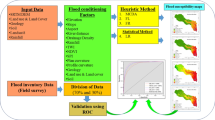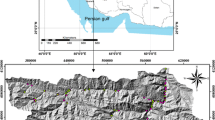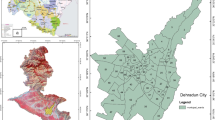Abstract
The Valley of Kashmir has been the site of more than fifty disastrous floods since 635 AD. Srinagar district has been inundated numerous times, since it emerged after the discharge of the large Karewa Lake from the Jhelum valley. In September 2014, cumulative effect of the south-west monsoon and the western disturbances, i.e., the storms that originate in the Caspian or Mediterranean Sea and deliver non-monsoon rainfall to north-west India, exasperated the discharge of Jhelum River, causing widespread inundation in the Kashmir valley. In this research, flood susceptibility zonation of Srinagar district using weights-of-evidence (WofE), frequency ratio (FR) and fuzzy gamma operator (FGO) has been carried out in a geographic information system. WofE and FR models are applied as autonomous data-driven techniques. FGO, on the other hand, is applied in the FR-based objective version and decision-makers knowledge-based subjective version. The novelty of the present study is that it augments FGO with subjective knowledge of a group of decision-makers using a fuzzy simple additive weighting system. Thirteen flood conditioning factors were considered for analysis including elevation, slope, slope aspect, profile curvature, plan curvature, Topographic Wetness Index, Stream Power Index, Sediment Transport Index, Topographic Roughness Index, geology, Modified Fournier Index, Land Use/Land Cover and distance from natural streams. In order to create and validate flood susceptibility index (FSI) maps, a flood inventory database obtained by digital change detection analysis of Landsat 8 OLI/TIRS images was segmented into training and test datasets and utilized for developing and validating the maps. All the resultant maps rationally illustrate the spatial susceptibility of the Srinagar district to flood. Area under the curve (AUC) was used to calculate prediction and success rates in order to determine the efficacy of the proposed methodologies. It shows that all FSI maps have ‘good’ success and prediction performance. However, the FR map has the highest success rate (AUC = 0.873), while the subjective FGO map achieves the highest prediction performance (AUC = 0.869). As such, the study reveals that the accuracy standards of FGO could be enhanced by means of incorporating of the subjective judgment. Additionally, the study indicates that the aforementioned flood susceptibility mapping techniques are significantly reliable, especially in the Himalayan regions.














Similar content being viewed by others
References
Abdalla, F. (2012). Mapping of groundwater prospective zones using remote sensing and GIS techniques: A case study from the Central Eastern Desert Egypt. Journal of African Earth Sciences. https://doi.org/10.1016/j.jafrearsci.2012.05.003
Agterberg, F. P. (1992). Combining indicator patterns in weights-of-evidence modeling for resource evaluation. Nonrenewable Resources, 1(1), 39–50. https://doi.org/10.1007/BF01782111
Agterberg, F. P., Bonham-Carter, G. F., Cheng, Q., & Wright, D. F. (1993). Weights-of-evidence modeling and weighted logistic regression for mineral potential mapping. In J. C. Davis & U. C. Herzfeld (Eds.), Computers in geology, 25 years of progress (pp. 13–32). Oxford University Press.
An, P., Moon, W. M., & Renez, A. (1991). Application of fuzzy set theory for integration of geological, geophysical and remote sensing data. Canadian Journal of Exploration Geophysics, 27, 1–11.
Armaş, I. (2012). Weights of evidence method for landslide susceptibility mapping. Prahova Subcarpathians Romania. Natural Hazards, 60, 937–950.
Aziz, K., Rai, S., & Rahman, A. (2015). Design flood estimation in ungauged catchments using genetic algorithm-based artificial neural network (GAANN) technique for Australia. Natural Hazards, 77, 805–821. https://doi.org/10.1007/s11069-015-1625-x
Barbieri, G., & Cambuli, P. (2009). The weight of evidence statistical method. In landslide susceptibility mapping of the Rio Pardu Valley (Sardinia, Italy) 18th world IMACS/MODSIM congress, Cairns, Australia.
Bhat, S. M., AhmadB, A. A., Farooq, H., & Ahmad, S. (2019). Flood hazard assessment of the Kashmir Valley using historical hydrology. Journal of Flood Risk Management, 12(Suppl. 1), e12521. https://doi.org/10.1111/jfr3.12521
Bonham-Carter, G. F. (1991). Integration of geoscientific data using GIS. In M. F. Goodchild, D. W. Rhind, & D. J. Maguire (Eds.), Geographic information systems: principle and applications (pp. 171–184). Longman.
Bonham-Carter, G. F. (1994). Geographical information system for geoscientists: Modelling with GIS. Pergamon Press.
Bonham-Carter, G. F. (2002). Geographic information systems for geoscientist: Modeling with GIS (pp. 302–334). Pergamon.
Bonham-Carter, G. F., Agterberg, F. P., & Wright, D. F. (1988). Integration of geological datasets for gold exploration in Nova Scotia. PhotogrEng Remote Sens, 54, 1585–1592.
Bonham-Carter, G. F., Agterberg, F. P., & Wright, D. F. (1989). Weights-of-evidence modeling: A new approach to mapping mineral potential. Statistical Applications in the Earth Science, Geological Survey of Canada Paper, 89–9, 171–183.
Bui, D. T., Tsnagaratos, P., Ngo, P., Pham, T. D., & Pham, T. B. (2019). Flash Flood Susceptibility modelling using an optimized fuzzy rule-based feature selection technique and tree based ensemble methods. Science of Total Environment, 668, 1038–1054. https://doi.org/10.1016/j.scitotenv.2019.02.422
Carranza, E. J. M., & Castro, O. (2006). Predicting lahar-inundation zones: Case study in West Mount Pinatubo, Philippines. Natural Hazards, 37, 331–372. https://doi.org/10.1007/s11069-005-6141-y
Carranza, E. J. M., & Hale, M. (2002). Evidential belief functions for datadriven geologically constrained mapping of gold potential, Baguio district, Philippines. Ore Geol R, 22, 117–132. https://doi.org/10.1016/S0169-1368(02)00111-7
Casas, A., Lane, S. N., Yu, D., & Benito, G. (2010). A Method for parameterising roughness and topographic sub-grid scale effects in hydraulic modelling from LiDAR data. Hydrology and Earth System Sciences, 14(8), 1567–1579. https://doi.org/10.5194/hess-14-1567-2010
Cheng, Q., & Agterberg, F.P (1999). Fuzzy weights-of-evidence method and its application in mineral potential mapping. Natural Resources Research, 8, 27–35. https://doi.org/10.1023/A:1021677510649
Chou, S., Chang, Y., & Shen, C. (2008). A fuzzy simple additive weighting system under group decision-making for facility location selection with objective/subjective attributes. European Journal of Operational Research., 189, 132–145. https://doi.org/10.1016/j.ejor.2007.05.006
Costache, R. (2019). Flash-flood potential index mapping using weights-of-evidence, decision trees models and their novel hybrid integration. Stochastic Environmental Research and Risk Assessment, 33, 1375–1402. https://doi.org/10.1007/s12040-017-0828-9
Costache, R., & Zaharia, L. (2017). Flash-flood potential assessment and mapping by integrating the weights-of-evidence and frequency ratio statistical methods in GIS environment–case study: BâscaChiojdului River catchment (Romania). Journal of Earth System Science, 126, 59. https://doi.org/10.1007/s12040-017-0828-9
Dahal, R. K., Hasegawa, S., Nonomura, A., Yamanaka, M., Dhakal, S., & Paudyal, P. (2008b). Predictive modeling of rainfall-induced landslide hazard in the Lesser Himalaya of Nepal based on weights-of evidence. Geomorphology, 102(3–4), 496–510. https://doi.org/10.1016/j.geomorph.2008.05.041
Dahal, R. K., Hasegawa, S., Nonomura, A., Yamanaka, M., Masuda, T., & Nishino, K. (2008a). GIS-based weights-of-evidence modeling of rainfall-induced landslides in small catchments for landslide susceptibility mapping. Environmental Geology, 54(2), 314–324.
Ercanoglu, M., & Gokceoglu, C. (2002). Assessment of landslide susceptibility for a landslide prone area (north of Yenice, NW Turkey) by fuzzy approach. Environmental Geology, 41, 720–730. https://doi.org/10.1007/s00254-001-0454-2
Falah, F., Rahmati, O., Rostami, M., Ahmadisharaf, E., Daliakopoulos, I.N., Pourghasemi, H.R. (2019). Artificial Neural Networks for Flood Susceptibility Mapping in Data-Scarce Urban Areas, In Spatial Modeling in GIS and R for Earth and Environmental Sciences, pp. 323–336. https://doi.org/10.1016/B978-0-12-815226-3.00014-4
Getachew, N., & Meten, M. (2021). Weights-of-Evidence modeling for landslide susceptibility mapping of Kabi-Gebro locality, Gundomeskel area Central Ethiopia. Geoenvironmental Disasters, 8, 6. https://doi.org/10.1186/s40677-021-00177-z
Gigović, L., Pamučar, D., Bajić, Z., & Drobnjak, S. (2017). Application of GIS-interval rough AHP methodology for flood hazard mapping in Urban areas. Water, 9, 360. https://doi.org/10.3390/w9060360
Haq, M., Akhtar, M., Muhammad, S., Paras, S., & Rahmatullah, J. (2012). Techniques of remote sensing and GIS for flood monitoring and damage assessment: A case study of Sindh province, Pakistan. The Egyptian Journal of Remote Sensing and Space Science, 15(2), 135–141. https://doi.org/10.1016/j.ejrs.2012.07.002
Hermas, E., Gaber, A., & El Bastawesy, M. (2021). Application of remote sensing and GIS for assessing and proposing mitigation measures in flood-affected urban areas Egypt. The Egyptian Journal of Remote Sensing and Space Science, 24(1), 119–130. https://doi.org/10.1016/j.ejrs.2020.03.002
Hong, H., Ilia, I., Tsnagaratos, P., Chen, W., & Xu, C. (2017). A hybrid fuzzy weight of evidence method in landslide susceptibility analysis on the Wuyuan area, China. Geomorphology, 290, 1–16. https://doi.org/10.1016/j.geomorph.2017.04.002
Hong, H., Tsnagaratos, P., Ilia, J., Liu, J., Zhu, A., & Chen, W. (2018). Application of fuzzy weight of evidence and data mining techniques in construction of flood susceptibility map of Poyang County, China. Science of Total Environment, 625, 575–588. https://doi.org/10.1016/j.scitotenv.2017.12.256
Kayastha, P., Bijukchhen, S. M., Dhital, M. R., & Smedt, F. D. (2013). GIS based landslide susceptibilty mapping using a fuzzy logic approach: A case study from Ghurmi-Dhad Khola Eastern Nepal. Journal of Geological Society of India, 82, 249–261.
Khosravi, K., Nohani, E., Maroufinia, E., & Pourghasemi, H. R. (2016). A GIS-based flood susceptibility assessment and its mapping in Iran: A comparison between frequency ratio and weights-of evidence bivariate statistical models with multi-criteria decision-making technique. Natural Hazards, 83(2), 947–987. https://doi.org/10.1007/s11069-016-2357-2
Kourgialas, N. N., & Karatzas, G. P. (2011). Flood management and a GIS modelling method to assess flood-hazard areas—a case study. Hydrological Sciences Journal, 56(2), 212–225. https://doi.org/10.1080/02626667.2011.555836
Kumar, R., & Acharya, P. (2016). Flood hazard and risk assessment of 2014 floods in Kashmir Valley: A space-based multisensor approach. Natural Hazards, 84, 437–464. https://doi.org/10.1007/s11069-016-2428-4
Lee, M. J., Kang, J. E., & Kim, G. (2015). Application of fuzzy combination operators to flood vulnerability assessments in Seoul Korea. Geocarto International, 30(9), 1052–1075. https://doi.org/10.1080/10106049.2015.1027290
Lee, S., Kim, J. C., Jung, H. S., Lee, M. J., & Lee, S. (2017). Spatial prediction of flood susceptibility using random-forest and boosted-tree models in Seoul metropolitan city, Korea. Geomatics, Natural Hazards and Risk, 8(2), 1185–1203. https://doi.org/10.1080/19475705.2017.1308971
Mathew, J., Jha, V. K., & Rawat, G. S. (2007). Weights-of-Evidence modeling for landslide hazard zonation mapping in part of Bhagirathi valley Uttarakhand. Current Science, 92(5), 628–638.
Mohammady, M., Pourghasemi, H. R., & Amiri, M. (2019). Assessment of land subsidence susceptibility in Semnan plain (Iran): A comparison of support vector machine and weights-of-evidence data mining algorithms. Natural Hazards, 99, 951–971. https://doi.org/10.1007/s11069-019-03785-z
Moore, I. D., Grayson, R., & Ladson, A. (1991). Digital terrain modelling: A review of hydrological, geomorphological, and biological applications. Hydrological Processes, 5(1), 3–30. https://doi.org/10.1002/hyp.3360050103
Niipele, J. N., & Chen, J. (2019). The usefulness of alos-palsar dem data for drainage extraction in semi-arid environments in The Iishana sub-basin. Journal of Hydrology: Regional Studies, 21, 57–67. https://doi.org/10.1016/j.ejrh.2018.11.003
Nitheshnirmal, S., Thilagaraj, P., Rahaman, S. A., & Jegankumar, R. (2019). Erosion risk assessment through morphometric indices for prioritisation of Arjuna watershed using ALOS-PALSAR DEM. Modeling Earth Systems and Environment, 5(3), 907–924.
Ouma, Y. O., & Tateishi, R. (2014). Urban flood vulnerability and risk mapping using integrated multi-parametric AHP and GIS: Methodological overview and case study assessment. Water, 6, 1515–1545. https://doi.org/10.3390/w6061515
Peng, Z. (1999). Jiangxi province levee atlas. Jiangxi Provincial Government Levee Department Publication, Nanchang, China (in Chinese).
Porwal, A., Carranza, E. J. M., & Hale, M. (2003). Knowledge-driven and data-driven fuzzy models for predictive mineral potential mapping. Natural Resources Research, 12, 1–25. https://doi.org/10.1023/A:1022693220894
Porwal, A., González-Álvarez, I., Markwitz, V., McCuaig, T. C., & Mamuse, A. (2010). Weights-of-evidence and logistic regression modeling of magmatic nickel sulfide prospectively in the YilgarnCraton Western Australia. Ore Geology Reviews, 38, 184–196.
Pourghasemi, H. R., Pradhan, B., Gokceoglu, C., & Moezzi, K. D. (2013). A comparative assessment of prediction capabilities of Dempster-Shafer and weights-of-evidence models in landslide susceptibility mapping using GIS. Geomatics, Natural Hazards and Risk, 4(2), 93–118. https://doi.org/10.1080/19475705.2012.662915
Pradhan, B. (2010). Flood susceptible mapping and risk area delineation using logistic regression, GIS and remote sensing. Journal of Spatial Hydrology, 9 (2).
Pradhan, A. M. S., & Kim, Y. T. (2017). Spatial data analysis and application of evidential belief functions to shallow landslide susceptibility mapping at Mt. Umyeon, Seoul Korea. Bulletin of Engineering Geology and the Environment, 76(4), 1263–1279. https://doi.org/10.1007/s10064-016-0919-x
Rahman, M. R., & Thakur, P. K. (2018). Detecting, mapping and analysing of flood water propagation using synthetic aperture radar (SAR) satellite data and GIS: A case study from the Kendrapara District of Orissa State of India. The Egyptian Journal of Remote Sensing and Space Science, 21(1), S37–S41. https://doi.org/10.1016/j.ejrs.2017.10.002
Rahmati, O., Pourghasemi, H. R., & Zeinivand, H. (2015). Flood susceptibility mapping using frequency ratio and weights-of-evidence models in the Golastan Province Iran. Geocarto International. https://doi.org/10.1080/10106049.2015.1041559
Ramesh, V., & Iqbal, S. S. (2020). Urban flood susceptibility zonation mapping using evidential belief function, frequency ratio and fuzzy gamma operator models in GIS: a case study of Greater Mumbai Maharashtra India. Geocarto International. https://doi.org/10.1080/10106049.2020.1730448
Rawat, J. S., & Kumar, M. (2015). Monitoring land use/cover change using remote sensing and GIS techniques: A case study of Hawalbagh block, district Almora, Uttarakhand, India. The Egyptian Journal of Remote Sensing and Space Science, 18(1), 77–84. https://doi.org/10.1016/j.ejrs.2015.02.002
Ray, K., Bhan, S., Bandopadhyay, B.K. (2015). The catastrophe over Jammu and Kashmir in September 2014: A meteorological observational analysis. Current science. Accepted.
Regmi, A. D., Devkota, K. C., Yoshida, K., Pradhan, B., Pourghasemi, H. R., Kumamoto, T., & Akgun, A. (2013). Application of frequency ratio, statistical index, and weights-of-evidence models and their comparison in landslide susceptibility mapping in Central Nepal Himalaya. Arabian Journal of Geosciences. https://doi.org/10.1007/s12517-012-0807-z
Regmi, N. R., Giardino, J. R., & Vitek, J. D. (2010). Assessing susceptibility to landslides: Using models to understand observed changes in slopes. Geomorphology, 112, 25–38. https://doi.org/10.1016/j.geomorph.2010.05.009
Samanta, R. K., Bhunia, G. S., & Shit, P. K. (2018). Flood susceptibility mapping using geospatial frequency ratio technique: A case study of Subarnarekha River Basin India. Modeling Earth Systems and Environment, 4, 395–408. https://doi.org/10.1007/s40808-018-0427-z
Sidle, R.C., Ochiai, H. (2006). Landslides: processes, prediction, and landuse. American Geophysical Union, Washington, D.C. Water Res Monograph, 18, p. 312.
Sneha Mittal, S., Nagar, V., Moral, S., & Teli, B. (2018). Preparation of flood model and hazard estimation on Yamuna River (using GIS and remote sensing). International Research Journal of Engineering and Technology (IRJET), 05(03), 3591–3597.
Srivastava, V., Srivastava, H., & Lakhera, R. C. (2010). Fuzzy gamma based geomatic modeling for landslide hazard susceptibility in a part of Tons River valley, north-west Himalaya, India. Geomatics, Natural Hazards and Risk, 1(3), 225–242. https://doi.org/10.1080/19475705.2010.490103
Stefanidis, S., & Stathis, D. (2013). Assessment of flood hazard based on natural and anthropogenic factors using analytic hierarchy process (AHP). Natural Hazards, 68, 569–585. https://doi.org/10.1007/s11069-013-0639-5
Sturm, K., Glaser, R., Jacobeit, J., Deutsch, M., & Brazdil, R. (2001). Hochwasser in Mitteleuropa seit 1500 und ihre Beziehung zur atmosphärischen Zirkulation. Petermanns Geographische Mitteilungen, 145(6), 14–23.
Tehrany, M. S., Jones, S., & Shabani, F. (2019). Identifying the essential flood conditioning factors for flood prone area mapping using machine learning techniques. CATENA, 175, 174–192. https://doi.org/10.1016/j.catena.2018.12.011
Tehrany, M. S., Lee, M. J., Pradhan, B., Jebur, M. N., & Lee, S. (2014a). Flood susceptibility mapping using integrated bivariate and multivariate statistical models. Environment and Earth Science, 72, 4001–4015. https://doi.org/10.1007/s12665-014-3289-3
Tehrany, M. S., Pradhan, B., & Jebur, M. N. (2013). Spatial prediction of flood susceptible areas using rule-based decision tree (DT) and a novel ensemble bivariate and multivariate statistical models in GIS. Journal of Hydrology, 504, 69–79. https://doi.org/10.1016/j.jhydrol.2013.09.034
Tehrany, M. S., Pradhan, B., & Jebur, M. N. (2014b). Flood susceptibility mapping using a novel ensemble weights of-evidence and support vector machine models in GIS. Journal of Hydrology, 512, 332–343. https://doi.org/10.1016/j.jhydrol.2014.03.008
Tehrany, M. S., Pradhan, B., Mansor, S., & Ahmad, N. (2014c). Flood susceptibility assessment using GIS-based support vector machine model with different kernel types. CATENA, 125, 91–101.
Tehrany, M. S., Shabani, F., Jebur, M. N., Hong, H., Chen, W., & Xie, X. (2017). GIS-based spatial prediction of flood prone areas using standalone frequency ratio, logistic regression, weight of evidence and their ensemble techniques. Geomatics, Natural Hazards and Risk, 8(2), 1538–1561. https://doi.org/10.1080/19475705.2017.1362038
Termeh, S. V. R., Kornejady, A., Pourghasemi, H. R., & Keesstra, S. (2018). Flood susceptibility mapping using novel ensembles of adaptive neuro fuzzy inference system and metaheuristic algorithms. Science of the Total Environment, 615, 438–451. https://doi.org/10.1016/j.scitotenv.2017.09.262
Wu, C. L., & Chau, K. W. (2006). A flood forecasting neural network model with genetic algorithm. International Journal of Environment and Pollution, 28, 261–273.
Yilmaz, I. (2009). Landslide susceptibility mapping using frequency ratio, logistic regression, artificial neural networks and their comparison: A case study from Kat landslides (Tokat—Turkey). Computers & Geosciences, 35, 1125–1138. https://doi.org/10.1016/j.cageo.2008.08.007
Zadeh, L. A. (1965). Fuzzy sets. Information and Control, 8(3), 338–353. https://doi.org/10.1016/S0019-9958(65)90241-X
Zimmermann, H. J. (1985). Fuzzy set theory and its applications. Klummer Nijholf.
Author information
Authors and Affiliations
Corresponding author
Additional information
Publisher's Note
Springer Nature remains neutral with regard to jurisdictional claims in published maps and institutional affiliations.
About this article
Cite this article
Majid, S.I., Kumar, M., Kumar, P. et al. GIS-Based Flood Susceptibility Mapping of Srinagar District, India Using Weights-of-Evidence (WofE), Frequency Ratio (FR) and Fuzzy Gamma Operator (FGO). J Indian Soc Remote Sens 51, 2421–2446 (2023). https://doi.org/10.1007/s12524-023-01776-z
Received:
Accepted:
Published:
Issue Date:
DOI: https://doi.org/10.1007/s12524-023-01776-z




